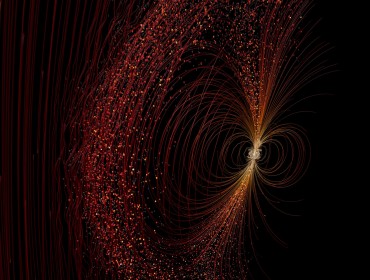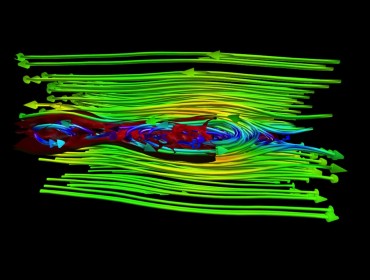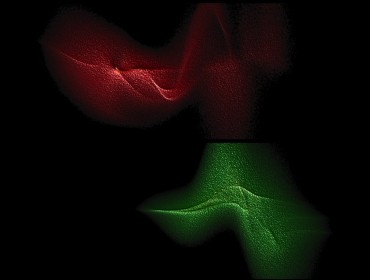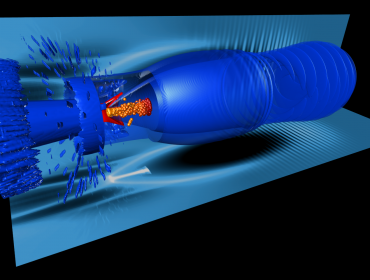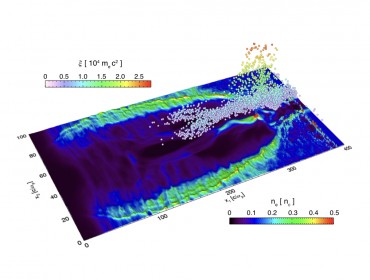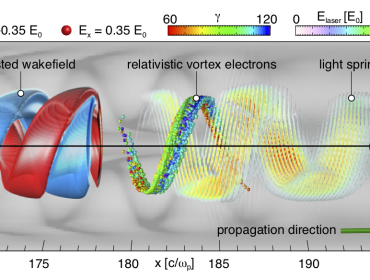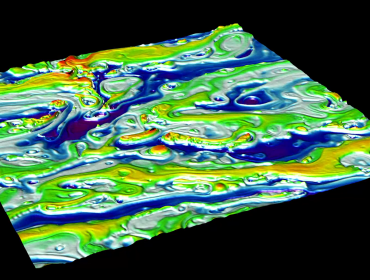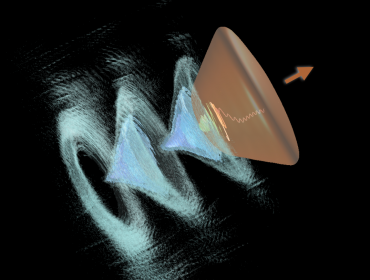-
Energetic electrons in bow shock turbulence
Read moreCollisionless shocks and turbulent plasma regions are often found in space and astrophysical magnetized plasma-obstacle interactions. In the moderate magnetic fields of objects such as comets or small lunar magnetic anomalies, the plasma electrons are tied to the field lines, whereas the ions may stream across them. In these conditions, plasma waves in the lower-hybrid range can be excited. Lower-hybrid waves can be resonant with both electrons propagating along the background magnetic field and ions moving perpendicularly to it, efficiently mediating an energy transfer between the two species. This property of lower-hybrid waves has been extensively explored to drive current in magnetic fusion devices .
This figure depicts the acceleration process of electrons (spheres) in the magnetic field (lines in orange-red) of a dipolar object through the waves generated on the shock front (wavy line pattern). The results shown here were obtained in a three-dimensional particle-in-cell simulation performed to reproduce the conditions…
January 17, 2018 -
Relativistic Magnetic Reconnection: Magnetic Flux Tubes and Kinks in the Current Sheet
Read moreIn extreme astrophysical environments, where plasmas are composed of electron positron pairs, the magnetic field energy is often so strong that the process of magnetic reconnection can generate flows that approach the speed of light. The significant energy contained in the magnetic fields is directed to acceleration of particles, heating, and the generation of bulk flows of charged particles via relativistic magnetic reconnection. We have performed a 3D ab initio PIC simulation of relativistic magnetic reconnection, starting from a Harris equilibrium, where most of the energy is in the form of magnetic fields. The movie shows a snapshot of oppositely directed magnetic fields and the associated current sheet after magnetic reconnection has developed. The magnetic field lines are colored by magnitude from weak (purple) to strongest (green), and are separated by a current sheet shown in red. Three key phenomena that occur during this process are highlighted: 1) The…
January 17, 2018 -
Monoenergetic ion beam from improved laser-induced magnetic vortex acceleration
Read moreHigh quality ion beam can potentially be used for wide-ranging fields. The advent of ultra-hight intensity laser provides access to laboratory-sized compact ion accelerator via the intense accelerating fields in the laser-plasma interactions. Magnetic vortex acceleration (MVA) is proposed to produce collimated energetic ion beams in near-critical/underdense gas plasmas. Furthermore, the gas plasma allows the laser ion acceleration to be operated with a high repetition rate. The picture shows the generation of a collimated ion beam (moving upward along the vertical axis of the picture) when a relativistic laser is incident into an underdense plasma. However, for the conventional MVA, the number of accelerated ions are rather low and the corresponding spectrum is exponentially decreasing. We have proposed in our research an advanced target design in which the underdense plasma is contained within an overdense tube. In such integrated targets, the electrons in the tube can be replenished to…
January 17, 2018 -
Kinking twin beams
Read moreThe upgrade of the electron positron collider at SLAC (FACET II) promises to deliver dense, energetic and high-quality beams with the aim to study High Field QED (see FACET-II Science Workshop 2017).
However, at the interaction point (IP) of the collider, there are effects (disruption, kink instability) that must be accounted for and coupled with QED processes in the design of fruitful experiments. With the PIC code OSIRIS, we simulated the self-consistent beam-beam interaction dynamics including the effect of a transverse misalignment of the two colliding beams and incorporating as well the QED processes of photon emission (non-linear Compton scattering) and pair production (Breit-Wheeler).
The video shows the evolution of the positron beam (red) and the electron beam (green) density. The two beams propagate horizontally. During the beam-beam interaction time, disruption effect, QED pair production and kink unstable modes come into play all together. Each beam pinches under the…
January 17, 2018 -
Beam compression by a blowout wakefield in a beam ionized plasma
Read moreIn our ongoing collaboration modelling and simulating recent experiments done at SLAC, we have a similar setup as the one from the energy doubling experiment . An initially neutral Lithium gas has longitudinal profile as shown in Fig. 1.
Figure 1: Neutral Lithium longitudinal profile. The red dots represent experminetal data and the blue line is the fit used in our simulations.
A 20 GeV electron beam, with typical SLAC parameters, is used to both ionize the gas and to drive wakefield. In the first centimetres of propagation the gas density is so low that there is not significant ionization happening and the beam shape is unchanged.
As the beam propagates up the ramp of the density profile, ionization starts to become significant. A key feature is that the timescale to field-ionize the gas is shorter than the bunch duration. Therefore, the tail of the beam starts to interact with the wakefield….
January 17, 2018 -
Plasma density down-ramp: a way to control the reproducibility of self-injected beams in LWFA
Read moreThe possibility of using a plasma density down-ramp injection scheme for laser wakefield acceleration has been known for almost two decades . While electrons with small impact parameters are deflected by the wake and the ones with large are hardly perturbed, somewhere in between there is a narrow sheath of impact parameters whose electrons eventually create a high-density region in the rear of the wake. These electrons are also very energetic, but they will only be useful for trapping and acceleration if their velocity is bigger than the phase velocity of the wake.
At this point, we call attention for the relevance of the down-ramp injection scheme. The phase velocity of the wake is slowed while it passes through…
January 17, 2018 -
Electrons surf the pipe!
Read moreThe figure shows electron plasma density and the energy of trapped electrons (for clarity, we show only a random sample of particles with energy over 1 GeV). The channel wall density is about 30 – 40 % of the critical plasma density (the density opaque for laser light), while in the inside of the channel the plasma density is below 5 % of that value. This structure guides light such that most of the energy travels through the low-density region.
Due to the high laser intensity (a0 ~ 600, I ~ 5 x 1023 W/cm2 ), the interaction between the light and plasma electrons is highly nonlinear. The electrons quiver in the laser field, while at the same time being affected by the collective plasma electromagnetic fields formed within the channel. In addition to the inherent nonlinearity of the interaction, relativistic electrons also emit high-frequency radiation. Sometimes, they convert a…
January 17, 2018 -
All optical control of the topology of plasma accelerators
Read more
The ability to shape the topology of plasma waves is a remarkable feature, which remains largely unexplored, and that may have deep ramifications into basic plasma physics and relativistic nonlinear optics. This feature is particularly interesting in the context of particle acceleration as it allows to shape the structure of the plasma in unique and novel ways, which are currently inaccessible to more conventional approaches.
January 17, 2018 -
Large scale PIC simulation of high beta magnetorotational instability
Read moreMagnetorotational instability (MRI) is a crucial mechanism for the amplification of magnetic field in astrophysical accretion disks, characterised by a state of differential rotation around a massive central object, such as neutron stars or black holes. The video shows a particle-in-cell (PIC) simulation of the evolution of the toroidal magnetic field in the meridian plane of a portion of a pair plasma (electron-positron) accretion disk, where the dimensions of the simulation box are small compared to the distance of the simulation from the centre of rotation. During the early time of the simulation, the MRI amplifies the magnetic field on the proper wavelength of the instability. Due to the collisionless nature of PIC simulations, the growth of the magnetic field activates a pressure anisotropy in the plasma. This anisotropy triggers another instability called mirror instability, which modifies the structure of the MRI magnetic field with oblique filaments of the…
July 6, 2017 -
Fast electrons gain energy both from the driving laser and its wake
Read moreOur knowledge of matter and energy is shaped by extreme scenarios explored only in current colliders. Thus, unveiling the physical mysteries beyond the energy frontier requires future, more compact and efficient, schemes where relativistic colliding particles reach even higher energies and unknown phenomena take place. For light elementary particles, such as leptons, our community resorts to linear configurations, without synchrotron radiation energy losses, typically RF accelerators. However, in standard RF technologies the accelerating gradients are limited to about 100MeV/m in order to prevent its constituent material breakdown. Budker proposed the use of the plasma media collective fields as means for the energy transfer. Their pioneer concept consisted of sending a short laser pulse trough a plasma gas cell where it developed a wake of plasma density oscillations with associated fields capable of accelerating particles with gradients in the order of the GeV/m. Since then…
January 27, 2017
extreme plasma physics > Visualizations

